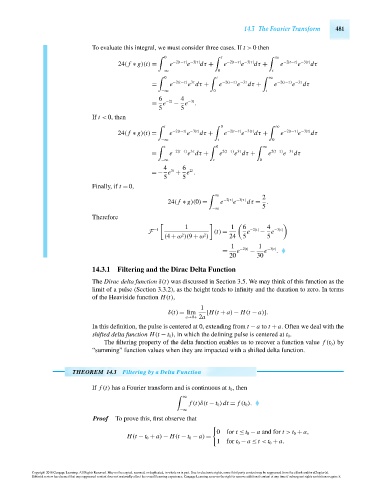Page 501 - Advanced engineering mathematics
P. 501
14.3 The Fourier Transform 481
To evaluate this integral, we must consider three cases. If t > 0 then
0 t ∞
e
e
e
24( f ∗ g)(t) = e −2|t−τ| −3|τ| dτ + e −2|t−τ| −3|τ| dτ + e −2|t−τ| −3|τ| dτ
−∞ 0 t
0 t ∞
e
e
e dτ +
= e −2(t−τ) 3τ e −2(t−τ) −3τ dτ + e −2(t−τ) −3τ dτ
−∞ 0 t
6 4
= e −2t − e −3t .
5 5
If t < 0, then
t 0 ∞
e
e
e
24( f ∗ g)(t) = e −2|t−τ| −3|τ| dτ + e −2|t−τ| −3|τ| dτ + e −2|t−τ| −3|τ| dτ
−∞ t 0
t 0 ∞
e
e dτ +
= e −2(t−τ) 3τ e 2(t−τ) 3τ e 2(t−τ) −3τ dτ
e dτ +
−∞ t 0
4 6
3t
2t
=− e + e .
5 5
Finally, if t = 0,
∞ 2
e
24( f ∗ g)(0) = e −2|τ| −3|τ| dτ = .
5
−∞
Therefore
1 1 6 4
−1
F (t) = e −2|t| − e −3|t|
(4 + ω )(9 + ω ) 24 5 5
2
2
1 1
= e −2|t| − e −3|t| .
20 30
14.3.1 Filtering and the Dirac Delta Function
The Dirac delta function δ(t) was discussed in Section 3.5. We may think of this function as the
limit of a pulse (Section 3.3.2), as the height tends to infinity and the duration to zero. In terms
of the Heaviside function H(t),
1
δ(t) = lim [H(t + a) − H(t − a)].
a→0+ 2a
In this definition, the pulse is centered at 0, extending from t − a to t + a. Often we deal with the
shifted delta function H(t − t 0 ), in which the defining pulse is centered at t 0 .
The filtering property of the delta function enables us to recover a function value f (t 0 ) by
“summing” function values when they are impacted with a shifted delta function.
THEOREM 14.3 Filtering by a Delta Function
If f (t) has a Fourier transform and is continuous at t 0 , then
∞
f (t)δ(t − t 0 )dt = f (t 0 ).
−∞
Proof To prove this, first observe that
0 for t ≤ t 0 − a and for t > t 0 + a,
H(t − t 0 + a) − H(t − t 0 − a) =
1 for t 0 − a ≤ t < t 0 + a.
Copyright 2010 Cengage Learning. All Rights Reserved. May not be copied, scanned, or duplicated, in whole or in part. Due to electronic rights, some third party content may be suppressed from the eBook and/or eChapter(s).
Editorial review has deemed that any suppressed content does not materially affect the overall learning experience. Cengage Learning reserves the right to remove additional content at any time if subsequent rights restrictions require it.
October 14, 2010 16:43 THM/NEIL Page-481 27410_14_ch14_p465-504

